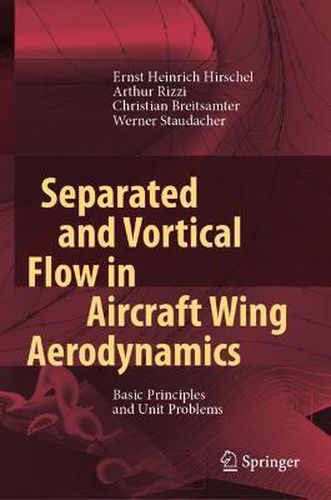Separated and Vortical Flow in Aircraft Wing Aerodynamics: Basic Principles and Unit Problems
Ernst Heinrich Hirschel,Arthur Rizzi,Christian Breitsamter,Werner Staudacher

Separated and Vortical Flow in Aircraft Wing Aerodynamics: Basic Principles and Unit Problems
Ernst Heinrich Hirschel,Arthur Rizzi,Christian Breitsamter,Werner Staudacher
This title is printed to order. This book may have been self-published. If so, we cannot guarantee the quality of the content. In the main most books will have gone through the editing process however some may not. We therefore suggest that you be aware of this before ordering this book. If in doubt check either the author or publisher’s details as we are unable to accept any returns unless they are faulty. Please contact us if you have any questions.
Fluid mechanical aspects of separated and vortical flow in aircraft wing aerodynamics are treated. The focus is on two wing classes: (1) large aspect-ratio wings and (2) small aspect-ratio delta-type wings. Aerodynamic design issues in general are not dealt with.
Discrete numerical simulation methods play a progressively larger role in aircraft design and development. Accordingly, in the introduction to the book the different mathematical models are considered, which underlie the aerodynamic computation methods (panel methods, RANS and scale-resolving methods). Special methods are the Euler methods, which as rather inexpensive methods embrace compressibility effects and also permit to describe lifting-wing flow.
The concept of the kinematically active and inactive vorticity content of shear layers gives insight into many flow phenomena, but also, with the second break of symmetry—the first one is due to the Kutta condition—an explanation of lifting-wing flow fields. The prerequisite is an extended definition of separation: flow-off separation at sharp trailing edges of class (1) wings and at sharp leading edges of class (2) wings. The vorticity-content concept, with a compatibility condition for flow-off separation at sharp edges, permits to understand the properties of the evolving trailing vortex layer and the resulting pair of trailing vortices of class (1) wings. The concept also shows that Euler methods at sharp delta or strake leading edges of class (2) wings can give reliable results.
Three main topics are treated:
1) Basic Principles are considered first: boundary-layer flow, vortex theory, the vorticity content of shear layers, Euler solutions for lifting wings, the Kutta condition in reality and the topology of skin-friction and velocity fields.
2) Unit Problems treat isolated flow phenomena of the two wing classes. Capabilities of panel and Euler methods are investigated. One Unit Problem is the flow past the wing of the NASA Common Research Model. Other Unit Problems concern the lee-side vortex system appearing at the Vortex-Flow Experiment 1 and 2 sharp- and blunt-edged delta configurations, at a delta wing with partly round leading edges, and also at the Blunt Delta Wing at hypersonic speed.
3) Selected Flow Problems of the two wing classes. In short sections practical design problems are discussed. The treatment of flow past fuselages, although desirable, was not possible in the frame of this book.
This item is not currently in-stock. It can be ordered online and is expected to ship in 7-14 days
Our stock data is updated periodically, and availability may change throughout the day for in-demand items. Please call the relevant shop for the most current stock information. Prices are subject to change without notice.
Sign in or become a Readings Member to add this title to a wishlist.


